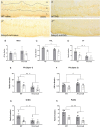Early life stress exacerbates behavioural and neuronal alterations in adolescent male mice lacking methyl-CpG binding protein 2 (Mecp2)
- PMID: 36082308
- PMCID: PMC9447412
- DOI: 10.3389/fnbeh.2022.974692
Early life stress exacerbates behavioural and neuronal alterations in adolescent male mice lacking methyl-CpG binding protein 2 (Mecp2)
Abstract
The methyl-CpG binding protein 2 gene (MECP2) encodes an epigenetic transcriptional regulator implicated in neuronal plasticity. Loss-of-function mutations in this gene are the primary cause of Rett syndrome and, to a lesser degree, of other neurodevelopmental disorders. Recently, we demonstrated that both Mecp2 haploinsuficiency and mild early life stress decrease anxiety-like behaviours and neuronal activation in brain areas controlling these responses in adolescent female mice. Here, we extend this work to males by using Mecp2-null and wild type adolescent mice subjected to maternal separation and their non-stressed controls. We assessed their behavioural responses in a battery of anxiety-provoking tests. Upon exposure to an elevated plus maze in aversive conditions, we evaluated changes in c-FOS expression in stress- and anxiety-related brain regions. In addition, we assessed the impact of maternal separation in neuronal maturation using doublecortin and reelin as surrogate markers. Mutant males showed reduced motor abilities, increased activation of the olfactory bulbs, probably due to breathing abnormalities, and decreased activation of the paraventricular thalamic nucleus, when compared to wild type mice. In addition, maternal separation increased the number of immature doublecortin-like neurons found in Mecp2-null animals. Moreover, this work shows for the first time that reelin is decreased in the mutant animals at the olfactory tubercle, piriform cortex and hippocampal dentate gyrus, an effect also associated to maternal separation. Taken together, our results suggest that maternal separation exacerbates some phenotypical alterations associated with lack of MeCP2 in adolescent males.
Keywords: Rett sydrome; c-FOS; doublecortin; maternal separation; reelin.
Copyright © 2022 Torres-Pérez, Martínez-Rodríguez, Forte, Blanco-Gómez, Stork, Lanuza, Santos and Agustín-Pavón.
Conflict of interest statement
The authors declare that the research was conducted in the absence of any commercial or financial relationships that could be construed as a potential conflict of interest.
Figures






Similar articles
-
Doublecortin-immunoreactive neurons in the piriform cortex are sensitive to the long lasting effects of early life stress.Front Neurosci. 2024 Sep 16;18:1446912. doi: 10.3389/fnins.2024.1446912. eCollection 2024. Front Neurosci. 2024. PMID: 39351392 Free PMC article.
-
MeCP2 haplodeficiency and early-life stress interaction on anxiety-like behavior in adolescent female mice.J Neurodev Disord. 2021 Dec 11;13(1):59. doi: 10.1186/s11689-021-09409-7. J Neurodev Disord. 2021. PMID: 34895132 Free PMC article.
-
Lack of MeCP2 leads to region-specific increase of doublecortin in the olfactory system.Brain Struct Funct. 2019 May;224(4):1647-1658. doi: 10.1007/s00429-019-01860-6. Epub 2019 Mar 28. Brain Struct Funct. 2019. PMID: 30923887
-
Exploring the possible link between MeCP2 and oxidative stress in Rett syndrome.Free Radic Biol Med. 2015 Nov;88(Pt A):81-90. doi: 10.1016/j.freeradbiomed.2015.04.019. Epub 2015 May 8. Free Radic Biol Med. 2015. PMID: 25960047 Review.
-
The Role of MeCP2 in Regulating Synaptic Plasticity in the Context of Stress and Depression.Cells. 2022 Feb 21;11(4):748. doi: 10.3390/cells11040748. Cells. 2022. PMID: 35203405 Free PMC article. Review.
Cited by
-
Transition from Animal-Based to Human Induced Pluripotent Stem Cells (iPSCs)-Based Models of Neurodevelopmental Disorders: Opportunities and Challenges.Cells. 2023 Feb 7;12(4):538. doi: 10.3390/cells12040538. Cells. 2023. PMID: 36831205 Free PMC article. Review.
-
Doublecortin-immunoreactive neurons in the piriform cortex are sensitive to the long lasting effects of early life stress.Front Neurosci. 2024 Sep 16;18:1446912. doi: 10.3389/fnins.2024.1446912. eCollection 2024. Front Neurosci. 2024. PMID: 39351392 Free PMC article.
-
Deficits in olfactory system neurogenesis in neurodevelopmental disorders.Genesis. 2024 Apr;62(2):e23590. doi: 10.1002/dvg.23590. Genesis. 2024. PMID: 38490949 Free PMC article. Review.
-
Altered Microglial Plasticity in the Periaqueductal Grey of Pre-Symptomatic Mecp2-Heterozygous Mice Following Early-Life Stress.Neuromolecular Med. 2025 Jun 17;27(1):46. doi: 10.1007/s12017-025-08867-9. Neuromolecular Med. 2025. PMID: 40526341 Free PMC article.
References
LinkOut - more resources
Full Text Sources
Molecular Biology Databases

